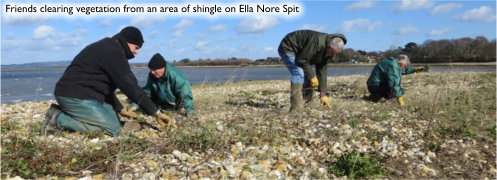
Little Terns spend their winters on the western coasts of Africa and return to Britain to breed on shingle spits, islands and beaches close to the high tide line.
In the past, Little Terns have nested and successfully raised young in Chichester Harbour, although, sadly no young have fledged from here since the 1990’s. a loss of suitable nesting habitat due to development pressure and rising sea levels washing away chicks and eggs from their low lying nests, disturbance from people and dogs off the lead in breeding colonies, limited availability of small fish close to their nesting areas along with natural predation.
Chichester Harbour Conservancy, together with its partners, is committed to managing the Harbour in a way that maximises the ability of birds to nest in summer and feed in their tens of thousands in winter. This March, with volunteer rangers from the Friends of Chichester Harbour, they cleared vegetation from an area of shingle on Ella Nore Spit in order to create more favourable nesting conditions for the Little Tern along with other sea-birds and waders that occasionally nest here. The Conservancy will also be erecting a temporary electric fence this spring on a small section of the spit in order to protect nesting birds from human and dog disturbance and ground predators.
James Parkin Chichester Harbour Conservancy’s Farming and Wildlife Officer said “Many of the drivers causing Little Terns breeding declines are out of our control, but if we as the general public remain on designated footpaths and keep dogs under close control in areas of importance for nature conservation, then we can relieve our disturbance pressure on these birds and be a part of their conservation effortâ€.